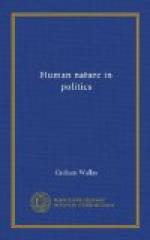Such figures, when they simply record the results of the fact that the likeness of the offspring to the parent in evolution is constantly inexact, are (like the records of other cases of ‘chance’ variation) fairly symmetrical, the greatest number of instances being found at the mean, and the descending curves of those above and those below the mean corresponding pretty closely with each other. Boot manufacturers, as the result of experience, construct in effect such a curve, making a large number of boots of the sizes which in length or breadth are near the mean, and a symmetrically diminishing number of the sizes above and below it.
In the next chapter I shall deal with the use in reasoning of such curves, either actually ‘plotted’ or roughly imagined. In this chapter I point out, firstly, that they can be easily remembered (partly because our visual memory is extremely retentive of the image made by a black line on a white surface) and that we can in consequence carry in our minds the quantitative facts as to a number of variations enormously beyond the possibility of memory if they were treated as isolated instances; and secondly, that we can by imagining such curves form a roughly accurate idea of the character of the variations to be expected as to any inherited quality among groups of individuals not yet born or not yet measured.
The third and last division under which knowledge of man can be arranged for the purposes of political study consists of the facts of man’s environment, and of the effect of environment upon his character and actions. It is the extreme instability and uncertainty of this element which constitutes the special difficulty of politics. The human type and the quantitative distribution of its variations are for the politician, who deals with a few generations only, practically permanent. Man’s environment changes with ever-increasing rapidity. The inherited nature of every human being varies indeed from that of every other, but the relative frequency of the most important variations can be forecasted for each generation. The difference, on the other hand, between one man’s environment and that of other men can be arranged on no curve and remembered or forecasted by no expedient. Buckle, it is true, attempted to explain the present and prophesy the future intellectual history of modern nations by the help of a few generalisations as to the effect of that small fraction of their environment which consisted of climate. But Buckle failed, and no one has attacked the problem again with anything like his confidence.
We can, of course, see that in the environment of any nation or class at any given time there are some facts which constitute for all its members a common experience, and therefore a common influence. Climate is such a fact, or the discovery of America, or the invention of printing, or the rates of wages and prices. All nonconformists are influenced by their memory of certain facts of which very few




